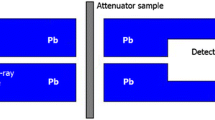Abstract
The mass attenuation coefficients of water, bakelite and concrete sample defined in the simulation package were obtained using the FLUKA Monte Carlo code at 59.5, 80.9, 140.5, 356.5, 661.6, 1173.2 and 1332.5 keV photon energies. The results for the mass attenuation coefficients obtained by simulation have been compared with experimental and the theoretical ones and good agreement has been observed. The results indicate that this process can be followed to determine the data on the attenuation of gamma-rays with the several energies in other materials. Also, the deposited energy by 661.6 keV photons at several thicknesses of each media was determined as being an important data for radiation shielding studies.





Similar content being viewed by others
References
Abdel-Rahman MA, Badawi EA, Abdel-Hady YL, Kamel N (2000) Effect of sample thickness on the measured mass attenuation coefficients of some compounds and elements for 59.54, 661.6 and 1332.5 keV γ-rays. Nucl Instrum Methods Phys Res A 447:432–436
Singh K, Singh H, Sharma G, Gerward L, Khanna A, Kumar R, Nathuram R, Sahota HS (2005) Gamma-ray shielding properties of CaO–SrO–B2O3 glasses. Radiat Phys Chem 72:225–228
Chanthima N, Prongsamrong P, Kaewkhao J, Limsuwan P (2012) Simulated radiation attenuation properties of cement containing with BaSO4 and PbO. Procedia Eng 32:976–981
Demir D, Keleş G (2006) Radiation transmission of concrete including boron waste for 59.54 and 80.99 keV gamma rays. Nucl Instrum Methods Phys Res B 245:501–504
Yılmaz E, Baltas H, Kırıs E, Ustabas İ, Cevik U, El-Khayatt AM (2011) Gamma ray and neutron shielding properties of some concrete materials. Ann Nucl Energy 38:2204–2212
Ramachandran N, Karunakaran Nair K, Abdullah KK, Varier KM (2006) Photon interaction studies using 241Am γ-rays. Pramana J Phys 67:507–517
Akar A, Baltaş H, Çevik U, Korkmaz F, Okumuşoğlu NT (2006) Measurement of attenuation coefficients for bone, muscle, fat and water at 140, 364 and 662 keV γ-ray energies. J Quant Spectrosc Radiat Transf 102:203–211
İshakoğlu A, Baytaş AF (2002) Measurement and evaluation of saturations for water, ethanol and a light non-aqueous phase liquid in a porous medium by gamma attenuation. Appl Rad Isot 56:601–606
Sidhu G, Singh K, Singh P, Mudahar GS (1999) Effect of collimator size and absorber thickness on gamma ray attenuation measurements for bakelite and perspex. Pramana J Phys 53:851–855
Bashter II (1997) Calculation of radiation attenuation coefficients for shielding concretes. Ann Nucl Energy 24:1389–1401
Akkurt I, El-Khayatt AM (2013) Effective atomic number and electron density of marble concrete. J Radioanal Nucl Chem 295:633–638
Gurler O, Akar Tarim U (2012) An investigation on determination of attenuation coefficients for gamma-rays by Monte Carlo method. J Radioanal Nucl Chem 293:397–401
Stankovic SJ, Ilic RD, Jankovic K, Bojovic D, Loncar B (2010) Gamma radiation absorption characteristics of concrete with components of different type materials. Acta Phys Pol A 117:812–816
Ferrari A, Sala PR, Fasso A, Ranft J (2005) FLUKA: A multi-particle transport code, CERN-2005-010, INFN TC_05/11, SLAC-R-773
Mark S, Khomchenko S, Shifrin M, Haviv Y, Schwartz JR, Orion I (2007) TVF-NMCRC—A powerful program for writing and executing simulation inputs for the FLUKA Monte Carlo code system. Nucl Instrum Methods Phys Res A 572:929–934
Wielopolski L, Song Z, Orion I, Hanson AL, Hendrey G (2005) Basic considerations for Monte Carlo calculations in soil. Appl Rad Isot 62:97–107
Berger MJ, Hubbell JH, Seltzer SM, Chang J, Coursey JS, Sukumar R, Zucker DS, Olsen K (2010). XCOM: photoncrosssectionsdatabase, NIST standard reference database 8 (XGAM). http://www.nist.gov/pml/data/xcom/index.cfm/. Accessed Jan 2013
Medhat ME (2009) Gamma-ray attenuation coefficients of some building materials available in Egypt. Ann Nucl Energy 36:849–852
Author information
Authors and Affiliations
Corresponding author
Rights and permissions
About this article
Cite this article
Demir, N., Tarim, U.A., Popovici, MA. et al. Investigation of mass attenuation coefficients of water, concrete and bakelite at different energies using the FLUKA Monte Carlo code. J Radioanal Nucl Chem 298, 1303–1307 (2013). https://doi.org/10.1007/s10967-013-2494-y
Received:
Published:
Issue Date:
DOI: https://doi.org/10.1007/s10967-013-2494-y




